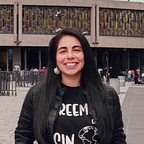Who lives, who dies, who tells your story: Princeton Seminary and Slavery
I arrived at my friend house in Princeton, New Jersey a day before attending a conference organized by Princeton Theological Seminary in order to spend time catching up and to share experiences. His 4-year-old daughter Aura, welcomed me with an amazing hug as her face lit up with joy. She had been told of the time when I had previously visited when she was only 10 months old and this story had been relayed by her parents; so, she knew it occurred, knew my name and she had been shown pictures. One photo had special significance because in it we were all present. Together we looked at the photo and reminisced of times gone by, and she asked who took the photo? We looked at each other and for a moment and did not remember. Did someone stop by and take the seems or was it simply the timer function of the camera? Aura asked a very perceptive question for a child, who took this photo? Her question persisted in my conscious as I attended the conference the following two-days.
The conference I attended was entitled Legacy and Mission: Theological Education and the History of Slavery (link to report). The one-and-a-half-day program was organized as part of the recommendations of a historical audit on the institution of slavery at the Seminary. The opening of the conference was highlighted by a group of professors that reflected on the experiences from other institutions (Georgetown University, William and Mary University, and Princeton University) in their own audits related to their participation in slavery, and only one of the participants was African-American.
After hearing from historians from Georgetown and William and Mary Universities regarding their legacy and use of enslaved people in their founding and early years I expected that Princeton University would have a similar history. Thus, it came as a surprise that the historian from Princeton boldly proclaimed “Princeton did not enslave anybody” according to its own historical record. However, several of the Universities founders, first Presidents, leaders and a plurality of its students owned and enslaved people. If a university, for that matter any organization, is defined by the people who make up its community it is seems disingenuous to proclaim the Institution did not enslave individuals? Finally, a Professor from Princeton Theological Seminary (a separate entity from Princeton University) spoke quickly about the report and focused his remarks about the historical references and potential paths forward one of which was hosting the present conference.
The intervening panels and presenters highlighted different aspects of the historical implications as well as many of the issues that are still present on the campus of the Princeton Theological Seminary and society today. All of the sessions were videocast and recorded to ensure there was a historical record of the presentations, questions, and discussions. However, at the end of the program on the second day, there was a panel composed of current students plus seminary faculty. In the first session that actually prioritized the voice of current African-American students, the cameras were removed, and the discussions were not recorded.
The discussion and reflections of the students drove to the heart of the matter of the history of slavery and the institution. Ideas of atonement and reparations were discussed as well as dispelling myths that still abound on the campus and in academia. As the program drew to a conclusion both participants, current students and alumni became ever more concerned that the conference and presentations represented more of an exercise on a checklist than an act of addressing historical wrongs.
The students are watching and want a real commitment from Princeton Seminary. The Association of Black Seminarians (ABS) have proposed that the seminary should commit at least 15% percent of its endowment as reparations to address historical wrongs and to ensure more diverse voices in academia. (To find out the exact request visit the ABS petition )
Returning back to the beginning and my friend’s daughter Aura’s question, I am sure that the timer function was used based on all the other photographic evidence. Reflecting on the conference with the eyes of a 4-year-old Aura, it appears as if the institution was basically saying that a horrible thing has happened in the past, but you know, what can we do about it now, reparations for what or even to who? Even though she had not heard the Hamilton soundtrack her question bears a resemblance to the familiar refrain — who lives, who dies, who tells your story and most importantly to me how it is passed on to future generations. The story of Princeton Theological Seminary is far from complete and completing the historical audit is only a first step.
My hope is that the audit and conference will not be the end of the story, but that the history of how people of faith purposely dehumanized others for their own gain is reflected upon and corrected. If we do not take these steps forward, we will be doomed to live a painful future. A 4-year-old asked a very important question that we should all consider and examine in-depth when it comes to the news and stories we hear on a daily basis. Who is taking the picture and how should we evaluate it in the context of equality, tradition, and justice?
